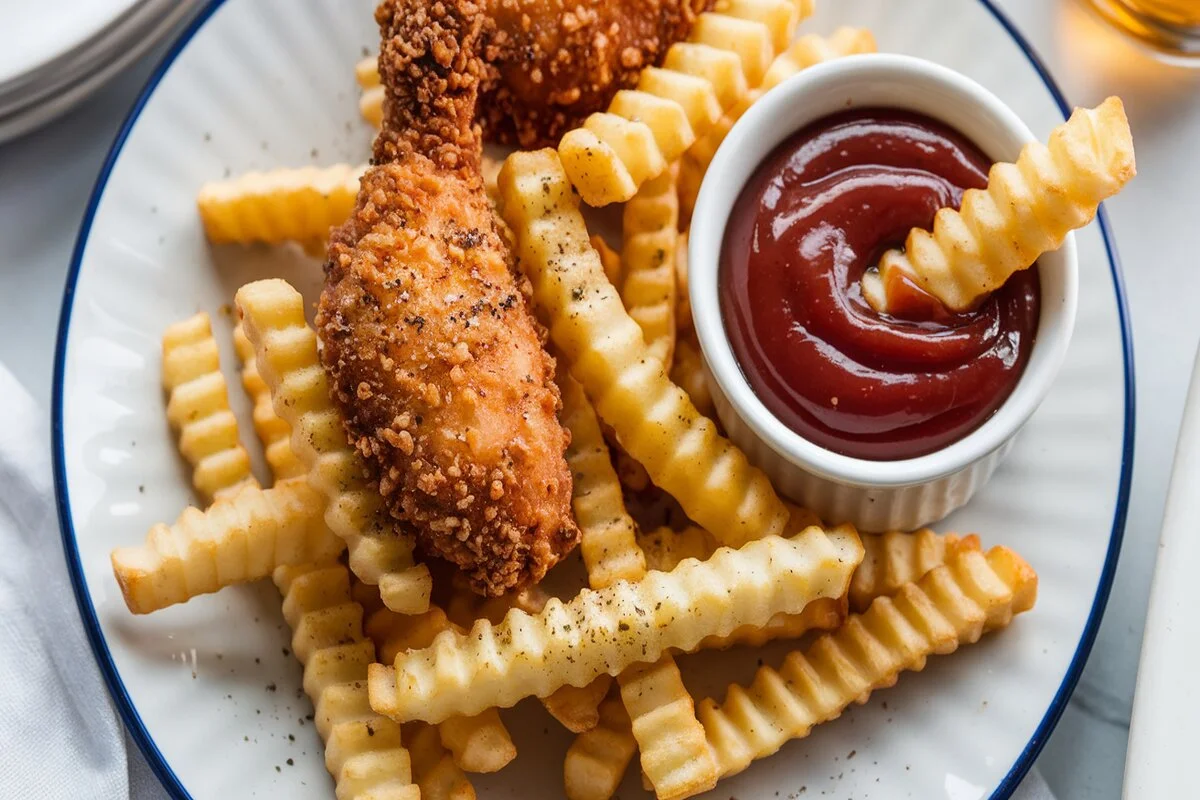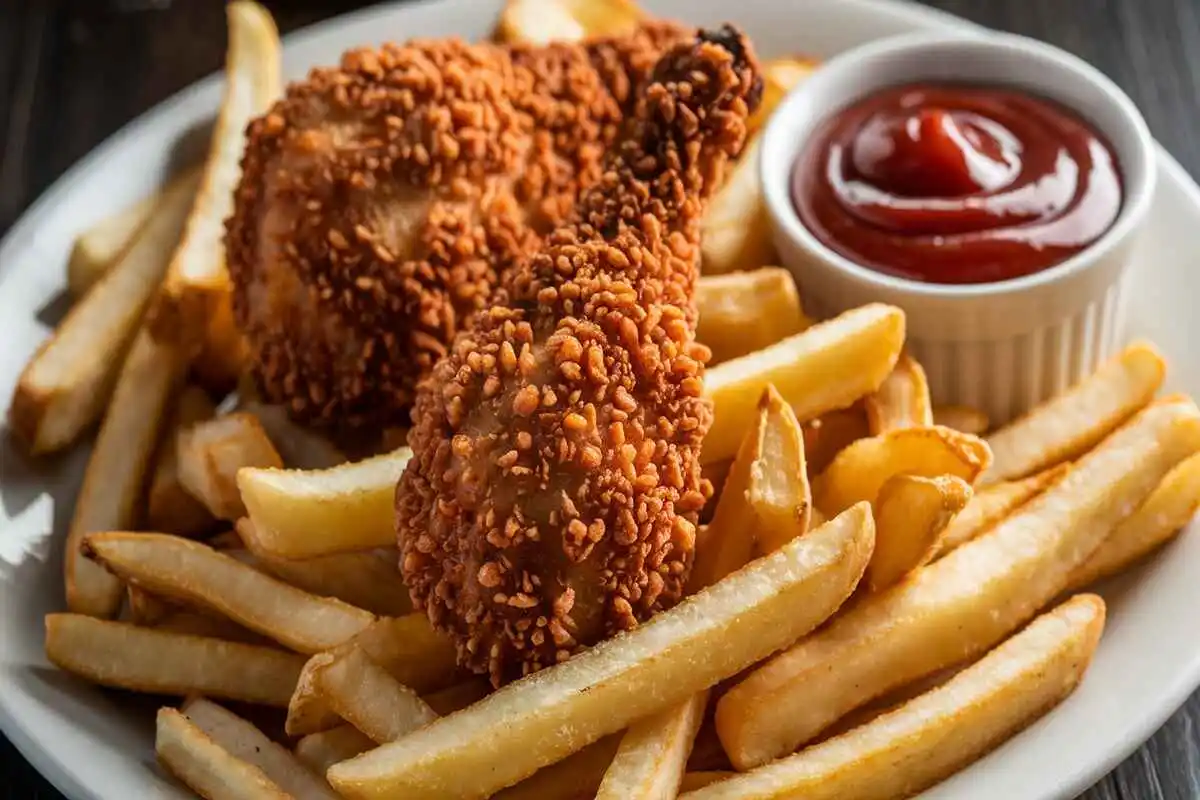Introduction
Chicken fries have emerged as a favorite snack among fast-food enthusiasts. First introduced by major chains like Burger King, these crispy, flavorful treats offer a delightful twist on traditional chicken snacks. Their unique fry-like shape makes them convenient and perfect for dipping, but what exactly are chicken fries made of? In this detailed guide, we’ll explore the ingredients, the process of making them, their nutritional content, and healthier alternatives. By the end, you’ll have a thorough understanding of chicken fries and how to create them at home.
Understanding Chicken Fries
Chicken fries are a creative hybrid of chicken nuggets and french fries. These thin, elongated strips of chicken are breaded and either deep-fried or baked to achieve a perfect crunch. The concept behind chicken fries was to create a snack that is easy to eat, shareable, and perfect for dipping. Their convenient shape has made them a popular choice for people on the go, particularly younger audiences who appreciate their portability and fun presentation.
Ingredients in Chicken Fries
The ingredients that make up chicken fries are straightforward, but each plays a critical role in achieving the desired flavor and texture:
- Primary Ingredients:
- Chicken breast or minced chicken is the primary ingredient. The choice of chicken affects the final product’s texture and flavor, with chicken breast providing a lean and tender base.
- Seasonings like onion salt, garlic salt, and kosher salt are used to enhance the flavor of the chicken.
- Coating Ingredients:
- Panko breadcrumbs are used for a light and crispy texture. Panko breadcrumbs, originating from Japan, are larger and flakier than traditional breadcrumbs, resulting in a crunchier coating.
- Crushed potato chips, such as Kettle Brand Salt and Pepper Potato Chips, add an extra layer of crunch and a unique flavor to the coating.
- Flour and eggs are essential for creating a base layer and binding the coating to the chicken.
- Fats and Oils:
- Butter or oil is used in the frying or baking process to achieve the golden-brown exterior that is characteristic of chicken fries. Baking is a healthier option, while frying provides a traditional, crunchy finish.
For a recipe that also creatively combines unexpected ingredients, check out what is pickle pizza made of. This innovative dish, like chicken fries, offers a unique take on traditional flavors.
How to Make Chicken Fries

Making chicken fries at home allows you to customize the flavor and texture. Here’s a step-by-step guide:
1. Preparing the Chicken
- Selecting the Chicken: Choose high-quality chicken breast, trimming off excess fat and cutting it into long, thin strips. This ensures that the chicken fries cook evenly.
- Marination: Marinating the chicken can enhance flavor and moisture. A simple marinade with buttermilk, garlic, and spices can make your chicken fries more tender and flavorful. Marinate for at least an hour or overnight.
2. Coating the Chicken
- Setting Up the Coating Station: Prepare three bowls—one with flour, one with beaten eggs, and one with a mixture of panko breadcrumbs and crushed potato chips. Season each bowl for added flavor.
- Dredging and Coating: Dredge each chicken strip in flour, shake off excess, dip it in eggs, and then roll it in the breadcrumb mixture. Ensure the coating adheres well by pressing lightly.
3. Cooking Methods
- Baking: Preheat your oven to 450°F (232°C). Place the coated chicken strips on a wire rack over a baking sheet to allow even cooking. Bake for 18-20 minutes until golden brown and crispy.
- Frying: Heat oil to 350°F (175°C) in a deep fryer or large skillet. Fry the chicken strips in batches, ensuring not to overcrowd the pan. Fry for 3-4 minutes per side, or until golden and cooked through.
4. Serving Suggestions
- Final Touches: Transfer the chicken fries to a paper towel-lined plate to drain excess oil. Serve hot with your favorite dipping sauces such as honey mustard, barbecue sauce, or ranch dressing.
For another chicken-based recipe that enhances the flavor of your chicken fries, try this chicken brine recipe. Brining your chicken before cooking can add extra juiciness and flavor.
Nutritional Breakdown
Understanding the nutritional content of chicken fries is important, especially if you’re mindful of your dietary choices:
Calories
- Chicken fries typically contain around 250-350 calories per serving. Baking instead of frying can significantly reduce the calorie count.
Protein
- Chicken fries offer approximately 15-20 grams of protein per serving, making them a decent snack choice for those looking to increase protein intake.
Fat
- The fat content in chicken fries can be high, especially if fried, with around 15-20 grams of fat per serving. Baking the fries can reduce this amount significantly.
Carbohydrates
- Carbohydrates mainly come from the coating, particularly the breadcrumbs and potato chips, contributing about 20-25 grams per serving.
Sodium
- Chicken fries can be high in sodium, particularly if heavily seasoned. It’s important to be mindful of sodium intake, especially if consuming store-bought or fried versions.
Making chicken fries at home allows you to control the ingredients and cooking methods, creating a healthier version that aligns with your dietary needs. For more tips on making healthier fried chicken, explore healthier fried chicken alternatives.
Homemade vs. Store-bought
Advantages of Homemade Chicken Fries
- Ingredient Control: Homemade chicken fries give you full control over the quality of ingredients. You can avoid preservatives and artificial flavors often found in store-bought versions.
- Customization: Homemade versions allow for endless customization with seasonings, coatings, and cooking methods to suit your taste.
- Health Benefits: Baking instead of frying reduces fat content. You can also use whole-grain breadcrumbs or gluten-free alternatives for added nutritional value.
Convenience of Store-bought Chicken Fries
- Consistency: Store-bought chicken fries offer convenience and consistent flavor, requiring just a few minutes of preparation.
- Time-saving: Ideal for busy individuals, pre-cooked and pre-seasoned options are quick and easy to prepare.
Cost Comparison
- Homemade Savings: While store-bought chicken fries offer convenience, they can be more expensive. Making them at home, especially in bulk, is often more cost-effective.
Alternatives to Chicken Fries
Looking to diversify or accommodate dietary needs? Consider these alternatives:
1. Vegetarian or Vegan Options
- Plant-based Chicken: Use tofu or plant-based chicken substitutes, seasoned and coated similarly to traditional chicken fries for a delicious meat-free option.
2. Gluten-Free Variations
- Alternative Coatings: Gluten-free panko breadcrumbs or crushed gluten-free crackers can replace traditional breadcrumbs. Almond flour or coconut flour can also be used.
3. Unique Breading Choices
- Experimentation: Crushed nuts (almonds, pecans), cornflakes, or even shredded coconut can provide different flavors and textures.
4. Air Frying
- Healthier Cooking: Air frying offers a lower-fat alternative to deep-frying while still achieving a crispy exterior.
To explore more unique fry variations, such as those with loaded toppings, check out the loaded fries recipes and ideas.
Serving Ideas for Chicken Fries
Chicken fries can be served in various ways, making them a versatile option for different occasions:
1. As a Snack or Appetizer
- Dipping Sauces: Serve chicken fries with honey mustard, barbecue sauce, ranch dressing, or sriracha mayo.
2. As a Main Course
- Side Pairings: Pair with vegetables or a salad for a balanced meal. Consider sides like oven-roasted potatoes, steamed broccoli, or a fresh garden salad.
3. In a Sandwich or Wrap
- Creative Serving: Layer chicken fries with lettuce, tomato, cheese, and your favorite sauce in a bun or tortilla for a tasty sandwich or wrap.
4. As a Topping
- Loaded or Nachos: Use chicken as a topping for loaded or nachos, adding cheese, jalapeños, sour cream, and salsa for a rich, flavorful dish.
Frequently Asked Questions
Here are answers to some common questions about chicken:
1. What Part of the Chicken is Used?
- Chicken Breast: Typically, chicken breast is used for its lean and tender texture, though minced chicken is also an option.
2. Are Chicken Healthy?
- Nutritional Considerations: While tasty, chicken can be high in fat and sodium, especially if fried. Baking and using healthier coatings can make them more nutritious.
3. Can Chicken be Baked Instead of Fried?
- Baking for Health: Yes, baking is a healthier option that still delivers a crispy texture. Air frying is another excellent alternative.
4. What Dipping Sauces Pair Well?
- Sauce Variety: Barbecue sauce, honey mustard, ranch dressing, and sriracha mayo are popular options. Homemade aioli or chipotle sauce can add a gourmet touch.
5. Can I Make Chicken Gluten-Free?
- Gluten-Free Adaptations: Use gluten-free breadcrumbs or coatings like almond flour or coconut flour to create a gluten-free version.
6. Shelf Life of Homemade Chicken?
- Storage Tips: Homemade chicken should be consumed within 2-3 days when refrigerated. They can also be frozen for longer storage.
Conclusion
Chicken are a delicious and versatile snack that can be enjoyed at home or from your favorite fast-food chain. By understanding the ingredients and process, you can customize them to suit your tastes and dietary needs. Whether you bake or fry them, experiment with coatings, or try out alternatives, fries are a snack that’s hard to resist.
For more culinary inspiration, visit Holly Recipes. From learning the differences between cookie mix and cake mix to mastering fudge, there’s always something new to explore in the kitchen. Whether you’re hosting a party or preparing a quick family meal, chicken are sure to be a hit.
